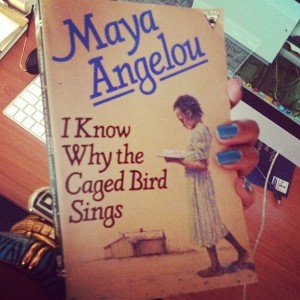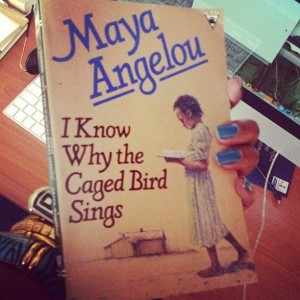 Maya Angelou wrote like a prosetry goddess. From the first page of her 1969 autobiography: I Know Why The Caged Bird Sings, to the last, words rhyme and dance as pages turn. The book details Maya’s early years— an incredible and moving tale of how an African-American woman defied rape, racism, segregation, black skin, ugly kinky hair and all odds, to find closure, forgiveness, and become outstanding.
Maya Angelou wrote like a prosetry goddess. From the first page of her 1969 autobiography: I Know Why The Caged Bird Sings, to the last, words rhyme and dance as pages turn. The book details Maya’s early years— an incredible and moving tale of how an African-American woman defied rape, racism, segregation, black skin, ugly kinky hair and all odds, to find closure, forgiveness, and become outstanding.
The story kicks off soon after three-year-old Maya and her beloved brother, four-year-old, Bailey Jnr. are sent off like cargo, by their separated parents, to Stamps, Arkansas to live with their larger than life grandmother Annie Henderson, whom they refer to as Momma. “The town reacted to us as its inhabitants had reacted to all things new before our coming. It regarded us a while without curiosity but with caution, and after we were seen to be harmless (and children) it closed in around us, as a real mother embraces a stranger’s child. Warmly, but not too familiarly.” Momma, popularly referred to as Sister Henderson by many, is the only Negro owning a store in Stamps that stocks all sorts of essentials for all, from canned fish, beef, flour to thread and sugar.
Momma’s famed store, church and school, become the only world Maya and Bailey know while growing up. They also live with Momma’s son, their crippled uncle Willie. It’s the 1930s and racism is at its high. Being black is hard and bad enough. When a white duo, teachers from a nearby school come into their store, for the first time in her life Maya sees her uncle struggle to stand still and upright, pretending not to be crippled. She writes, “He must have tired of being crippled, as prisoners tire of penitentiary bars and the guilty tire of blame.” This, she says, was the first time she felt like she understood and empathized with him the most.
Certain aspects of the book are insightful and carry with them circumstances that shape Maya’s future policies and identity. Born Marguerite Annie Johnson, the name Maya comes about as a result of Bailey’s inability to refer to his sister by name. To him, she was just his. “After Bailey learned definitely that I was his sister, he refused to call me Marguerite, but rather addressed me each time as “Mya Sister,” and in later more articulate years, after the need for brevity had shortened the appellation to “My,” it was elaborated into Maya.” While aged eight, Maya is raped by her mother’s boyfriend – a situation that traumatized her to the extent of being dumb for years. “Just my breath, carrying my words out, might poison people and they’d curl up and die … I had to stop talking … I was called impudent and my muteness sullenness when I refused to be a child …” This begins to be Maya’s relationship with scrutiny, silence and literature.
Maya’s interest in reading and poetry is mentored by a Negro, the fancy Mrs. Flowers, whom Maya credits as the person who gave her the first of lessons of living: “She said that I must be always intolerant of ignorance but understanding of illiteracy. That some people, unable to go to school, were more educated and even more intelligent than college professors.” Growing up in Stamps, then a little unknown town in the countryside, allows Maya to later look at the world differently and appreciate every single bit of what it offered, while blind to tragedy and prejudice. She says, “The resignation of Stamps’ inhabitants encouraged me to relax. Their decision to be satisfied with life’s inequities was a lesson for me.”
One time, the only white dentist in Stamps denies Momma and Maya an appointment just because Maya is a black kid. This is despite Momma having lent him money in the past, a favour he hadn’t returned. When Bailey witnesses the uncovering of a Negro murdered and dumped while tied up like a mummy, Momma moves Maya and Bailey from Stamps to city life with Vivian Baxter for good.
 Every difficulty and disappointment Maya encounters while growing up, until teenage years, moulds her razor-sharp memory, strong character and gift of forgiveness/arbitration. Despite growing up hardships and the difficulty of healing from rape, Maya still finds strength in the power of love, and family (even though disjointedly). She goes on to build a solid relationship with her brother (whom she refers to her Kingdom Come) and mother, Vivian Baxter. “To describe my mother would be to write about a hurricane in its perfect power. Or the climbing, falling colours of a rainbow,” she writes in escape of words to describe Vivian’s flamboyance, beauty and guts.
Every difficulty and disappointment Maya encounters while growing up, until teenage years, moulds her razor-sharp memory, strong character and gift of forgiveness/arbitration. Despite growing up hardships and the difficulty of healing from rape, Maya still finds strength in the power of love, and family (even though disjointedly). She goes on to build a solid relationship with her brother (whom she refers to her Kingdom Come) and mother, Vivian Baxter. “To describe my mother would be to write about a hurricane in its perfect power. Or the climbing, falling colours of a rainbow,” she writes in escape of words to describe Vivian’s flamboyance, beauty and guts.
By the age of seventeen, Maya becomes the first black person to operate a streetcar in San Francisco. She’s also slept in dumped cars, lived with street children, and got herself a baby boy— Guy Johnson. Her mother’s mentorship, belief in her greatness, together with Maya’s long-term assertiveness and power of knowing intelligence and wanting to only associate with greatness, must have been the propellers of Maya’s great legacy-to-be.
I Know Why The Caged Bird Sings reminds me of To Kill a Mockingbird, because of the juvenile narration, by younger Maya and nine-year-old Scout Jean Louise, respectively. Both books heavily feature themes of racism and segregation. There’s a lot of beauty in the narrators’ innocence and impression of adult behaviour and the power they’d have had if things were to run their way. This style of literature challenges us all to tap into our inner innocence and realise that like a bird; free or caged—it’s up to us to sing whatever song we deem fit.
BONUS: May Maya rest in eternal peace. And her books, poetry, drive and powerful words and that trembling deep voice continue to inspire us all. I Know Why the Caged Bird Sings is the most highly acclaimed of Angelou’s autobiographies. The book, one of a seven-volume series ends just as Guy is born to a young single and happy mother. Watch the below video of Maya’s son response to the question he’s been asked 1000 times.
